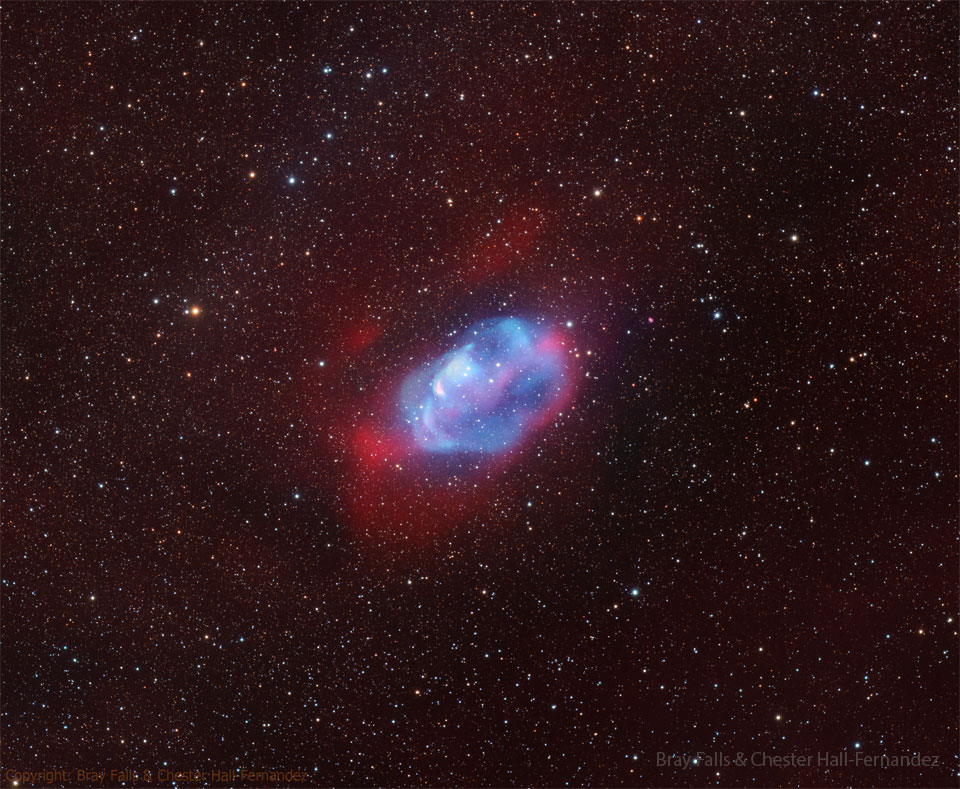22. August 2023
開喙豆星雲

探索宇宙1!逐工會揀一幅無仝款 ê 影像抑是相片,𤆬你熟似咱這个迷人 ê 宇宙,閣有專業天文學者2為你3解說4。
- 原始文章:The Pistachio Nebula
- 影像來源 kah 版權:Bray Falls & Chester Hall-Fernandez
- 台文翻譯:An-Li Tsai (NSYSU)
[漢羅] 開喙豆星雲
進前無人注意過這个星雲。 一般講來,新發現 ê 星雲 ê 視寸尺會較細,而且攏是 專業天文學家 用大型天文望遠鏡 揣著--ê。 毋過這个 開喙豆星雲 是 頂真 ê 業餘天文愛好者 揣著--ê。 而且,這个星雲暗罔暗,是 kah 咱月娘 ê 視寸尺差不多平大。 現代 ê 業餘天文愛好者 若是有細台天文望遠鏡,就會使 利用 tùi 天頂 進行長時間感光,提著比專業天文望遠鏡 閣較大區 ê 影像。 按呢 in 毋但會當揣著 某一个天體四箍圍仔 猶毋捌揣著--ê 大片發射區,嘛會使揣著 過去完全毋捌揣著--ê 天體,親像 星雲。 這張開喙豆星雲影像 ê 藍色是 酸素 發射線,紅色是 水素 發射線。 咱這馬 tùi 中央彼粒高溫恆星 ê 性質 是 無蓋了解。 毋過伊若是一粒 白矮星,這个星雲就有可能去 hŏng 標做 行星形星雲。 這張相片 是 7 月初 ê 時陣 tī Namibia 共和國 暗暝 開超過 70 點鐘 ê 感光時間 翕出來 ê 合成影像。
[POJ] Khui-chhùi-tāu Seng-hûn
Chìn-chêng bô-lâng chù-ì kòe chit-ê seng-hûn. It-poaⁿ kóng-lâi, sin hoat-hiān ê seng-hûn ê sī-chhùn-chhioh ē khah sè, jî-chhiáⁿ lóng sī choan-gia̍p thian-bûn ha̍k-ka iōng tōa-hêng thian-bûn bōng-oán-kiàⁿ chhōe-tio̍h--ê. M̄-koh chit-ê Khui-chhùi-tāu seng-hûn sī téng-chin ê gia̍p-û thian-bûn ài-hóⁿ-chiá chhōe-tio̍h--ê. Jî-chhiáⁿ, chit-ê seng-hûn àm bóng àm, sī kah lán goe̍h-niû ê sī-chhùn-chhioh chha-put-to pêⁿ tōa. Hiān-tāi ê gia̍p-û thian-bûn ài-hóⁿ-chiá nā-sī ū sè-tâi thian-bûn bōng-oán-kiàⁿ, to̍h ē-sái lī-iōng tùi thiⁿ-téng chìn-hêng tn̂g sî-kan kám-kng, the̍h-tio̍h pí choan-gia̍p thian-bûn bōng-oán-kiàⁿ koh-khah tōa khu ê iáⁿ-siōng. Án-ne in m̄-nā ē-tàng chhōe-tio̍h bó͘ chi̍t-ê thian-thé sì-kho͘-ûi-á iáu m̄-bat chhōe-tio̍h ê tōa-phiàn hoat-siā-khu, mā ē-sái chhōe-tio̍h kòe-khì oân-choân m̄-bat chhōe-tio̍h--ê thian-thé, chhin-chhiūⁿ seng-hûn. Chit-tiuⁿ Khui-chhùi-tāu Seng-hûn iáⁿ-siōng ê nâ-sek sī sàng-sò͘ hoat-siā-sòaⁿ, âng-sek sī chúi-sò͘ hoat-siā-sòaⁿ. Lán chit-má tùi tiong-ng hit lia̍p ko-un hêng-chhiⁿ ê sèng-chit sī bô kài liáu-kái. M̄-koh i nā-sī chi̍t-lia̍p pe̍h-é-chheⁿ, chit-ê seng-hûn to̍h ū khó-lêng khì hőng piau chò kiâⁿ-chheⁿ-hêng seng-hûn. Chit-tiuⁿ siòng-phìⁿ sī 7 goe̍h-chhe ê sî-chūn tī Namibia kiōng-hô-kok àm-mê khai chhiau-kòe 70 tiám-cheng ê kám-kng sî-kan hip--chhut-lâi ê ha̍p-sêng iáⁿ-siōng.
[KIP] Khui-tshuì-tāu Sing-hûn
Tsìn-tsîng bô-lâng tsù-ì kuè tsit-ê sing-hûn. It-puann kóng-lâi, sin huat-hiān ê sing-hûn ê sī-tshùn-tshioh ē khah sè, jî-tshiánn lóng sī tsuan-gia̍p thian-bûn ha̍k-ka iōng tuā-hîng thian-bûn bōng-uán-kiànn tshuē-tio̍h--ê. M̄-koh tsit-ê Khui-tshuì-tāu sing-hûn sī tíng-tsin ê gia̍p-û thian-bûn ài-hónn-tsiá tshuē-tio̍h--ê. Jî-tshiánn, tsit-ê sing-hûn àm bóng àm, sī kah lán gue̍h-niû ê sī-tshùn-tshioh tsha-put-to pênn tuā. Hiān-tāi ê gia̍p-û thian-bûn ài-hónn-tsiá nā-sī ū sè-tâi thian-bûn bōng-uán-kiànn, to̍h ē-sái lī-iōng tuì thinn-tíng tsìn-hîng tn̂g sî-kan kám-kng, the̍h-tio̍h pí tsuan-gia̍p thian-bûn bōng-uán-kiànn koh-khah tuā khu ê iánn-siōng. Án-ne in m̄-nā ē-tàng tshuē-tio̍h bóo tsi̍t-ê thian-thé sì-khoo-uî-á iáu m̄-bat tshuē-tio̍h ê tuā-phiàn huat-siā-khu, mā ē-sái tshuē-tio̍h kuè-khì uân-tsuân m̄-bat tshuē-tio̍h--ê thian-thé, tshin-tshiūnn sing-hûn. Tsit-tiunn Khui-tshuì-tāu Sing-hûn iánn-siōng ê nâ-sik sī sàng-sòo huat-siā-suànn, âng-sik sī tsuí-sòo huat-siā-suànn. Lán tsit-má tuì tiong-ng hit lia̍p ko-un hîng-tshinn ê sìng-tsit sī bô kài liáu-kái. M̄-koh i nā-sī tsi̍t-lia̍p pe̍h-é-tshenn, tsit-ê sing-hûn to̍h ū khó-lîng khì hőng piau tsò kiânn-tshenn-hîng sing-hûn. Tsit-tiunn siòng-phìnn sī 7 gue̍h-tshe ê sî-tsūn tī Namibia kiōng-hô-kok àm-mê khai tshiau-kuè 70 tiám-tsing ê kám-kng sî-kan hip--tshut-lâi ê ha̍p-sîng iánn-siōng.
[English] The Pistachio Nebula
This nebula had never been noted before. Newly discovered nebulas are usually angularly small and found by professionals using large telescopes. In contrast, the Pistachio Nebula was discovered by dedicated amateurs and, although faint, is nearly the size of the full Moon. In modern times, amateurs with even small telescopes can create long exposures over sky areas much larger than most professional telescopes can see. They can therefore discover both previously unknown areas of extended emission around known objects, as well as entirely unknown objects, like nebulas. The pictured Pistachio Nebula is shown in oxygen emission (blue) and hydrogen emission (red). The nature of the hot central star is currently unknown, and the nebula might be labeled a planetary nebula if it turns out to be a white dwarf star. The featured image is a composite of over 70 hours of exposure taken in early June under the dark skies of Namibia.
詞彙學習
| 漢羅 | POJ | KIP | 華語 | English |
|---|---|---|---|---|
| 開喙豆星雲 | Khui-chhùi-tāu seng-hûn | Khui-tshuì-tāu sing-hûn | 開心果星雲 | Pistachio Nebula |
| 視寸尺 | sī-chhùn-chhioh | sī-tshùn-tshioh | 視尺寸 | angularly |
| 業餘 | gia̍p-û | gia̍p-û | 業餘 | amateurs |
| 發射區 | hoat-siā-khu | huat-siā-khu | 發射區 | extended emission |
| 酸素 | sàng-sò͘ | sàng-sòo | 氧 | oxygen |
| 水素 | chúi-sò͘ | tsuí-sòo | 氫 | hydrogen |
| 發射線 | hoat-siā-sòaⁿ | huat-siā-suànn | 發射線 | emission line |
| 白矮星 | pe̍h-é-chheⁿ | pe̍h-é-tshenn | 白矮星 | white dwarf star |
| 行星形星雲 | kiâⁿ-chheⁿ-hêng seng-hûn | kiânn-tshenn-hîng sing-hûn | 行星狀星雲 | planetary nebula |
| Namibia 共和國 | Namibia kiōng-hô-kok | Namibia kiōng-hô-kok | 納米比亞共和國 | Namibia |